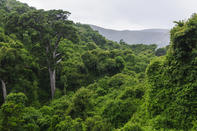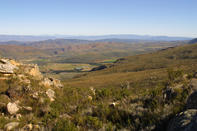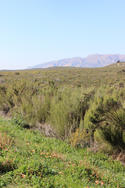A Spectacular Variety
Along the Garden Route, there are also the creamy-white flowering sprays of forest nuxia trees, stinkwoods and wild olives, white and red alders, saffronwood, Cape beech and holly trees, wild peach and pear — a spectacular variety. The trees and cliffs are draped with mosses and ferns, of which there are 25 different species, and lilies and orchids decorate the damp ground.

Blue duiker and bushbuck, tree hyraxes and leopards still haunt the sombre labyrinths of these fecund woods. The Tsitsikamma Forest is really made up of many large and small patches, relicts of the temperate evergreen forests that once covered a large part of south-eastern Africa.
But over the past few thousand years the climate here has become gradually and steadily drier, so that these once-great forests have shrunk to a size where they are hardly viable as a healthily functioning biome.
During the past two centuries man has helped reduce the stature of the remaining forests by burning and cutting them.
When the protective margin is disturbed, or roads are cut through a forest, a wound is opened that allows weeds, fire, excessive light and dryness to damage the cool and moist microclimate.
Lush Vegetation

With active protection it may be possible to save what temperate forests still remain, but as long as mankind continues to expand his domain they are unlikely ever again to spread outwards. The Outeniqua and Tsitsikamma mountains lie clothed in fynbos and forest, like close folds of velvet and corduroy.
This lush vegetation benefits from the generous year-round rain which is intercepted on the southern, sea-facing slopes of the mountains.
But behind these ranges the long, dry, interleading valleys receive generally less than 200 millimetres of rain a year. These valleys make up the Little Karoo region, which is a rain shadow desert smothered by the bunched-up pleats of rock.
While the geology of the Little Karoo, which lies inland of and parallel to the Garden Route, mainly between the Outeniqua and Swartberg ranges, is similar to that of the Cape Fold mountains, the vegetation is a south-eastward extension of the arid Succulent Karoo Biome.
This biological unit is found mainly along the Cape west coast, in the south abutting the Fynbos Biome's Strandveld component from about Verlorenvlei, to the Orange River, where it blends into the bleak Namib Desert.
Grazing Lands

Although the Little Karoo is generally much drier and less fertile than the main Karoo, the many rivers that flow through these valleys allow for cultivation along narrow alluvial margins. Fruit orchids and even vineyards are found around Oudtshoorn and all along the Olifants River, which lies in the widest and longest valley of the Little Karoo.
More daunting are places like 'Die Hel' which lies in the long-forgotten Gamka River Valley, between the Swartberg and Seweweekspoort passes in the Groot Swartberg range. Spiky aloes and fleshy euphorbias grow on the rocky valley floor, while dry scrub and thorn bush clings to the jagged mountain slopes.
A small group of white herders chanced upon this remote valley in the early 19th-century, while searching for new grazing lands, and there they stayed.
They lived in the old 'boer' tradition in the Garnka River Valley, forgotten by the outside world, until one generation ago when a road was cut through the valley and later a small school was built there. Dominating this part of the mighty Swartberg mountains, the Toverkop's twin bastions, 2 126 metres, loom behind the town of Ladismith.
Older Mountains - Southern Africa

The Outeniqua and Swartberg mountains, Kammanassie and Baviaanskloof ranges, as well as the many smaller folded mountain ranges follow the coastline from Cape Town to Cape St Francis, almost 700 kilometres to the east. These mountains were all formed many millions of years ago when the enormous southern continent of Gondwanaland broke up into various plates.
These movements of the earth's skin, which seems to us to be so solid, but is really like brittle plastic, resulted in a process called orographic folding: when the various plates that comprise the earth's crust push up against one another, one plate is invariably forced underneath another, and their edges either buckle upwards, or crumple in a series of folds.
Most of the world's highest mountain ranges have been formed in this way, including the Rockies and the Andes, the Alps and the Himalayas. In the case of the Cape's mountains, lateral folding coincided with compacting, so that today its peaks and ridges can be seen to be twisted and buckled both along and across the main axis folding — which is from west to east.
Before successive erosion cycles were set into motion, grinding down all protruding areas on the subcontinent and reducing mountains to beach sand, the peaks of the Cape Fold mountains would have been eclipsed only by the Himalayas and the highest peaks of the Andes.
This gives us some idea to how much older the mountains of southern Africa are than the others mentioned here, which will themselves one day be reduced to sea sand.
Ancient yellowwood, stinkwood and other hardwood giants prosper within the temperate embrace of the balmy Indian Ocean, creating a range of microhabitats within which narina trogon, osprey, caracal, bush pig and even leopard may be encountered.
5 000 Remaining Birds
Did you know: Jet black with red eyes, bill and legs, African black oystercatchers are unmistakable.
The best places to find them are on rocky shores or sandy beaches where people and dogs seldom venture. Of the estimated 5 000 remaining birds in Southern Africa, there's a good chance of seeing some on the Oystercatcher Trail or at the Goukamma Nature Reserve.
By David Bristow The Garden Route is a great way to explore the Cape Coastal region of South Africa. You can either embark on a self drive route, lingering l...
The Garden Route is a great way to explore the Cape Coastal region of South Africa. You can either embark on a self drive route, lingering l... There are South African Tourism Routes to suit you. Read this quick concise guide by independent travel writer Carrie Hampton and choose a r...
There are South African Tourism Routes to suit you. Read this quick concise guide by independent travel writer Carrie Hampton and choose a r...